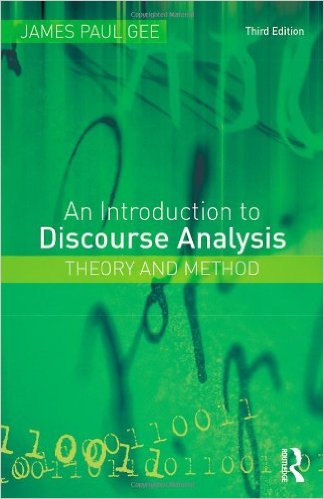 Gee, James Paul, An Introduction to Discourse Analysis: Theory and Method
Gee, James Paul, An Introduction to Discourse Analysis: Theory and Method. 3rd ed. New York: Routledge, 2011. 224 pp.
This work provides a methodology for doing discourse analysis in terms of critically analyzing the use of language as saying, doing, and being (3). The author utilizes speech act theory as well as later Wittgenstein’s “language game” theory. Language games have rules that produce winners and losers; winners receive “social goods,” which are “anything some people in a society want and value” (5-6). He argues that since social goods are always at stake in the use of language, language is always “political” in a deep sense (7).
Gee believes that “all discourse analysis needs to be critical, not because discourse analysts are or need to be political, but because language itself is . . . political” (9). Discourse analysis should be practical and applied to social issues (10-12). Gee believes that “language has meaning only in and through social practices, practices which often leave us morally complicit with harm and injustice unless we attempt to transform them” (12). He also says a tenet of this book is that “any proper theory of language is a theory of practice-or, as we have seen, of the ‘games’ we humans play” (12). Thus, while the title of his book does not reflect it, this work is on “critical discourse analysis,” which draws its tools freely from postmodern and neo-Marxian thinkers.
Gee’s “method” is actually “not intended as a set of ‘rules’ to be followed ‘step-by-step'” (125). It involves six tools-situated meanings, social languages, figured worlds, intertextuality, Discourses, and Conversations-and seven “building tasks of language”-significance, practices (activities), identities, relationships, politics (the distribution of social goods), connections, and sign systems and knowledge (17-20). The analyst uses these tools to discover how language is being used as a building task. This provides forty-two possible questions to be asked of any text (121). The validity of this analysis is social, not individual, and consists of four components: convergence (of the answers to the questions to each other), agreement from native speakers, coverage (applicability of results to related data), and its correct use of linguistic details (122-24). Chapters 10-12 provide three examples of Gee’s version of discourse analysis, while an appendix provides instructions for discourse analysis on images and multimodal texts.
While Gee’s work is helpful in teaching some facets of how language-in-use works, his method does do much more than perform simple exegesis, highlighting the connotative features of the text rather than the denotative features. Speech-act theory dominates in a sense, i.e., Gee focuses mostly on what the language is doing (illocutionary acts). In this respect, the book is useful; one may use the forty-two questions provided by Gee to uncover the illocutionary force of a discourse. Yet, one must also be aware of the postmodern and neo-Marxian factors at work in his assumptions of the building tasks of language. There is a definite hermeneutic of suspicion that pervades these assumptions: everybody does everything to gain power over one another in order to acquire social goods. For students wishing to learn discourse analysis for biblical interpretation, they should look elsewhere.
Find it here on Amazon.
